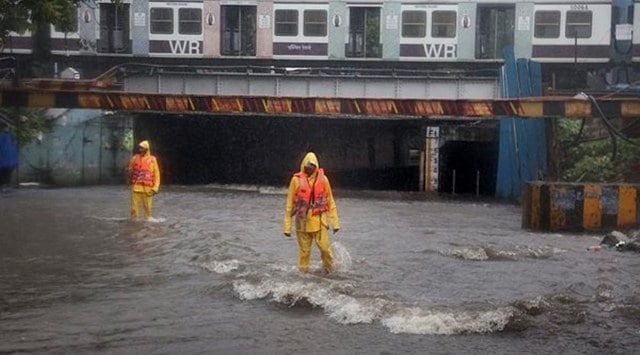Andheri subway remains water-logged in brief spell of rain or heavy downpour
Located at the heart of suburban Mumbai, the subway is a primary east-west link that has become infamous for its flooding woes.
 Located at the heart of suburban Mumbai, the Andheri subway is a primary east-west link that has become infamous for flooding. (File)
Located at the heart of suburban Mumbai, the Andheri subway is a primary east-west link that has become infamous for flooding. (File) Even when two chronic flood-spots of Mumbai — Gandhi Market and Hindmata — did not get water-logged during monsoon this year, the Andheri subway continues to get inundated even after a brief spell of rain.
Located at the heart of suburban Mumbai, the subway is a primary east-west link that has become infamous for its flooding woes.
However, this year, the situation is much worse since citizens are majorly dependent on this subway for their daily movement in the absence of Gopal Krishna Gokhale bridge which is presently shut for reconstruction. Since the arrival of monsoon in Mumbai on June 25, the subway has been shut for vehicular movement at least 15 times, over the past three weeks.
Geographical feature key factor
The subway is located around one km away from the Andheri station and is known to be one of the low-lying areas of the city.
Ahead of monsoon, the Brihanmumbai Municipal Corporation (BMC) had set up six dewatering pumps inside the subway to ensure that all the accumulated water is pumped out. However, the problem of water-logging continues to persist.
The location of the subway is saucer-shaped in nature, which means the entry and exit points of the subway are slightly lower than the level of the main carriageway of the existing roads.
The Mogra Nullah, which originates two km away from the subway, passes downstream touching the subway.
P. Velrasu, Additional Municipal Commissioner (Projects) says the geographical feature of this place is a contributing factor behind the flooding woes of this place.
“Since the subway is saucer-shaped, the curvature of the main-roads acts like a slope during the rains, due to which all water from outside travels downstream inside the subway and gets accumulated there. The Mogra nullah also passes adjoining this subway and since it flows downstream from here, the waterflow is very smooth and once it overflows, the rain-water automatically gets pushed inside the subway,” Velrasu said.
However this year, civic officials said, the duration of keeping the subway shut has reduced. The officials said that besides the geographical constraints, one more key contributing factor is choked drainage network.
The official said that even when the nullah flows downstream from here, unless the drains are free from floating waste there is always a chance of getting the channels blocked. “We have been holding dialogues with residents as well. However, no concrete result has happened yet,” said the official.
Residents’ woes
Local residents, however, blamed rampant construction work that has taken place around the subway over the years to be the primary contributor to the flooding situation.
Dhaval Shah, from Lokhandwala Oshiwara Citizen’s Association (LOCA), said that over the past one-decade real estate projects have come up rampantly in Andheri, which were built by encroaching the nullah.
“Just outside the subway, a concrete slab is being made which is obstructing the flow of water, unless this slab is broken, the water will continue to overflow. Unless the administration takes up much more constructed effort, problems like this will continue,” he said.
Raunak Aggarwal, another local resident who is also an urban planner said, “The point is most of the subways in Mumbai are saucer shaped yet it is the Andheri subway that gets submerged like this. The root cause of this problem is encroachment and haphazard garbage dumping, that eventually diverts the water into the subway from the drains.”
Way ahead
Velrasu said that the BMC has already chalked out a plan of creating a sump-pit to mitigate this issue. This sump-pit technology is the same model that the civic body has implemented in Hindmata, Gandhi Market and Milan subway to abate the flooding woes over there.
“Back in 2017-18, a proposal for diverting the drainage water through micro-tunneling method was pitched. This would cost Rs 150 crore to the civic body. However, back then the problem of water-logging in the subway was not this frequent,” Velrasu said.
He added that as an alternate measure the BMC will create a sump pit in the subway, that will be like an underground chamber to collect the accumulated rain water and channel it out through high-power pumps into the Mogra Nullah. The project is expected to cost between Rs 40 and Rs 50 crore. “The blueprint of this project is ready and we didn’t go ahead with this now because the Gokhale bridge is shut and digging the subway will also cause traffic obstruction. Once the bridge is ready by the end of this year, we will launch this project,” he added.







